Shaula, also known as Lambda Scorpii, is the second-brightest star system in the zodiacal constellation of Scorpius. It is the 24th brightest star in the night sky and it marks the scorpion’s stinger.
Key Facts & Summary
- Shaula is a triple star system located at around 570 light-years / 180 parsecs away from the Sun.
- The primary star is a Beta Cephei variable star, it changes its brightness quickly and its apparent magnitude varies from 1.62, 14.9, and 12.0. The star system’s absolute magnitude is – 3.70.
- The first two stars of the system are B-type stars, while the third is a pre-main sequence star.
- The primary star, Lambda Scorpii A is a hot blue-white subgiant of spectral type B2IV. It is currently unknown if it has stopped fusing hydrogen in its core.
- Lambda Scorpii A has around 14.5 solar masses and a radius of around 8.8 times that of the Sun.
- Lambda Scorpii A is very bright, around 36.300 times brighter than our sun.
- Lambda Scorpii B is a 15th magnitude star of class B2. It is 4 arcseconds away from the primary star.
- Lambda Scorpii B has around 9.6 solar masses and has a radius of 4.7 times that of the Sun. Its been classified as a spectral type DA7.9 star.
- Both A and B have surface temperatures estimated to be at around 25.000 K.
- Lambda Scorpii C is believed to be a pre-main sequence star, having a visual magnitude of 12.0 and it is 95 arcseconds away from the other stars.
- The Lambda Scorpii star system is believed to be at around 10 to 13 million years old.
- Lambda Scorpii A has a rotational velocity of around 150 kilometers / 93.2 miles per second.
- Lambda Scorpii A has a surface gravity of 3.8 cgs while B has 4.0 cgs.
The star’s traditional name Shaula comes from the Arabi language. It translates to “the raised tail” or “the Scorpion’s Stinger” due to the fact that Shaula marks the celestial scorpion’s stinger since it lies at the end of the tail together with another star named Lesath. Though the stars are close, they are not physically related.
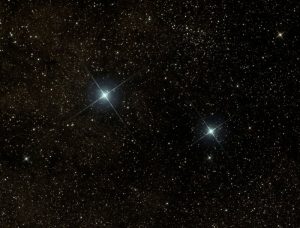
The star’s Latinised name is Lamda Scorpii, and it is designated as λ Scorpii, though for reasons unknown since Shaula isn’t the alpha star of its constellation. Shaula together with Lesath form an optical pair of stars commonly known as the “Cat’s Eyes.”
Formation
The Lambda Scorpii system consists of at least 3 confirmed stars that lie in the same orbital plane. This suggests that the stars may have formed at the same time.
Though their exact age is ambiguous, the star system’s age is speculated to be quite young, at around 10 to 13 million years old. The stars may have formed from the same gas and dust either from a nebula or a molecular cloud.
Gravity pulled the swirling gas and dust together, forming the three stars with Lambda Scorpii A being the most massive and thus being the gravitationally dominant star, making the others gravitationally bound to it.
Distance, Size, and Mass
The Lambda Scorpii system lies at around 570 light-years / 180 parsecs away from the Sun. The biggest star of this system is Lambda Scorpii A, the second is Lambda Scorpii B, and the smallest is speculated to be Lambda Scorpii C.
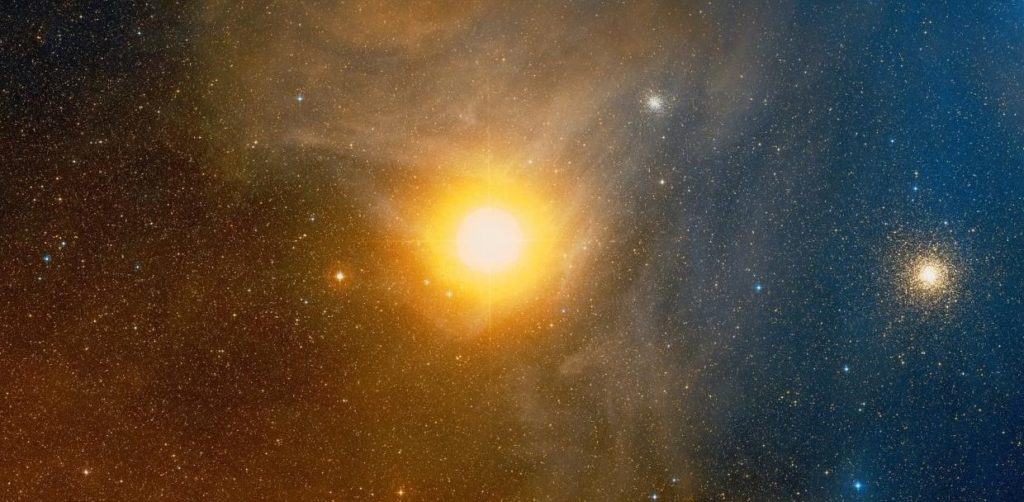
Lambda Scorpii A has around 14.5 solar masses and a radius of around 8.8 times that of the Sun. Lamba Scorpii B has around 9.6 solar masses and has a radius of 4.7 times that of the Sun. When it comes to Lambda Scorpii C, its physical characteristics regarding its size/mass are currently unknown.
Other Characteristics
Lambda Scorpii A is a hot blue-white subgiant of spectral type B2IV. It is currently unknown if it has stopped fusing hydrogen in its core or if it’s nearing this stage. It is the brightest star in its system, being around 36.300 times brighter than our sun.
Lambda Scorpii A is a Beta Cephei variable star, it changes its brightness quickly and for short periods of time, and its apparent magnitude varies from 1.62, 14.9, and 12.0. The star system’s absolute magnitude is – 3.70. Lambda Scorpii B is a 15th magnitude star of class B2.
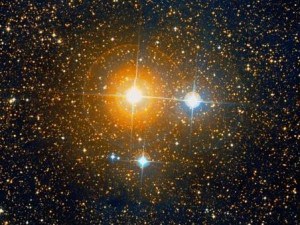
Both A and B are more than 4 times hotter than our sun, they have surface temperatures estimated to be at around 25.000 K, but when it comes to A, something is rather different.
Its pulsations are mainly caused due to its abundance of iron which lies deep beneath its surface. Temperatures there rise up to 200.000 K, thus the iron increases in its opacity. This creates a subsurface build-up of energy which increases pressure and pushes the layers out over several hours. Little is known about the third companion, Lambda Scorpii C, its visual magnitude is 12.0, and it is believed that it is a pre-main sequence star.
Stellar System
Lambda Scorpii B is separated from A by around 4 arcseconds, while Lambda Scorpii C lies 95 arcseconds away from them. B orbits A with a period of 1.053 days at an average distance of 5.7 AU, while C orbits them with a period of just under 6 days at a separation of 0.19 to 0.11 AU. All three stars lie in the same orbital plane.
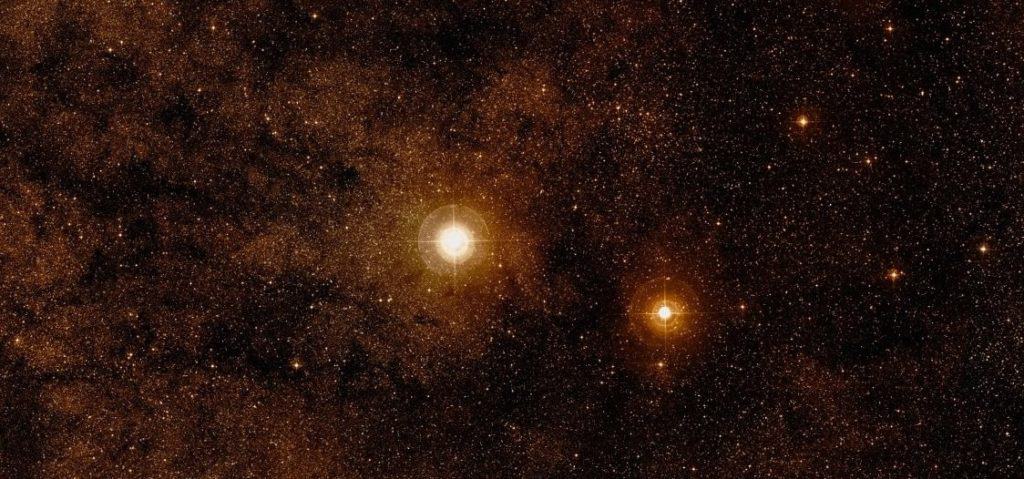
Location
Lambda Scorpii is located in the zodiacal constellation of Scorpius. All the zodiacal constellations were first catalogued by the Greco-Roman astronomer Ptolemy in the 2nd century A.D. The best time to observe this constellation and everything in it, is in the summer for those situated in the northern hemisphere and in winter/spring for those situated in the southern hemisphere.
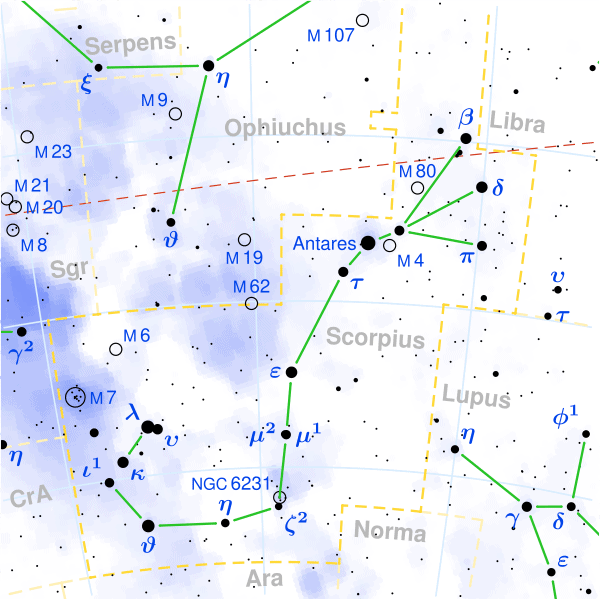
This constellation lies in the direction of the Milky Way’s centre. Many stars and deep-sky objects lie in it including the closest globular cluster to the solar system, Messier 4. Lambda Scorpii/Shaula is easy to find since the stars of Orion’s belt point directly at it. Shaula and another star named Lesath, both form an optical pair known as the Cat’s eyes.
The Future
Lambda Scorpii A is massive enough to explode as a supernova in the future. Though it is unknown if the star has stopped fusing hydrogen in its core, its ultimate fate sadly will end in a colossal explosion and will probably leave behind a white dwarf.
Did you know?
- For the Chinese, the star was known as Eight Star of the Tail – also pointing out its location.
- Both Shaula and its neighbor Lesath were listed in the Babylonian MUL.APIN as Sharur and Shargaz. In Coptic, the stars were known as Minamref – the sting.
- The aboriginal people of northwestern Victoria in Australia, called the Boorong, called Shaula and Lesath – Karik Karik – translating to “the Falcons.”
- The flag of Brazil features 27 stars with each and every one of them symbolizing a Brazilian Federative Unit. Shaula is one of these stars and it represents the state of Rio Grande do Norte.
- Both Shaula and a brighter, more famous star named Antares, are among the 58 stars selected for nagivation. Only the brightest stars which are also easily recognizable are part of this group.
- Shaula is considered to be the third brightest second magnitude star. Adhara, the second brightest star in Canis Majoris, and Castor, the second brightest in Gemini, are brighter.
- In comic books such as the Transformers, Shaula was depicted as being the star of which the homeworld of the Transformers orbit.
Sources:
Image source:
- https://en.es-static.us/upl/2018/02/shaula-lesath-300×228.jpg
- https://www.star-facts.com/wp-content/uploads/2019/11/Antares-1240×608.jpg?189db0&189db0
- https://www.constellation-guide.com/wp-content/uploads/2012/11/Zeta-Scorpii-300×225.jpg
- https://www.star-facts.com/wp-content/uploads/2019/09/Shaula.jpg?189db0&189db0
- https://upload.wikimedia.org/wikipedia/commons/thumb/1/1f/Scorpius_constellation_map.svg/600px-Scorpius_constellation_map.svg.png
